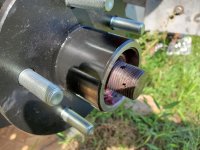Hi, First, apologies for the lack of proper terminology.
I just replaced the hubs on my sailboat trailer (of which I just purchased earlier this summer). The one hub was completely destroyed, I'm just glad I was only towing it a few times from the dry storage to the ramp. I measured the spindle up and determined that it's a 3500# hub. I ordered two new hubs and installed them, all went fine.
The castle nuts that were on the hubs originally did not have a washer with them. I ordered new nuts which came with a washer. There are two holes for the cotter pins to go through (one is maybe 1/4" in further out the spindle than the other (didn't measure, just rough guess).
It seems that if I use the washer, it puts the nut too far out for the inner hole but not far enough for the outer hole for the cotter pin.
The question is this: Should I not use the washer and just use the inner hole? This seems a bit weird because the cotter pin is set back within the hub cylinder slightly. Or, the other option I guess would be to add several washers and use the outer hole. One of the pictures shows the nut with the washer and using the outer hole but the pin doesn't line up nicely with the nut.
I'm trying to do this the correct way and not the hacky way. Thanks in advance for any advise.
I just replaced the hubs on my sailboat trailer (of which I just purchased earlier this summer). The one hub was completely destroyed, I'm just glad I was only towing it a few times from the dry storage to the ramp. I measured the spindle up and determined that it's a 3500# hub. I ordered two new hubs and installed them, all went fine.
The castle nuts that were on the hubs originally did not have a washer with them. I ordered new nuts which came with a washer. There are two holes for the cotter pins to go through (one is maybe 1/4" in further out the spindle than the other (didn't measure, just rough guess).
It seems that if I use the washer, it puts the nut too far out for the inner hole but not far enough for the outer hole for the cotter pin.
The question is this: Should I not use the washer and just use the inner hole? This seems a bit weird because the cotter pin is set back within the hub cylinder slightly. Or, the other option I guess would be to add several washers and use the outer hole. One of the pictures shows the nut with the washer and using the outer hole but the pin doesn't line up nicely with the nut.
I'm trying to do this the correct way and not the hacky way. Thanks in advance for any advise.





















